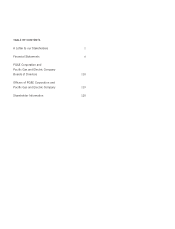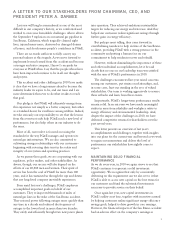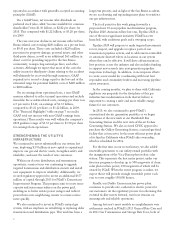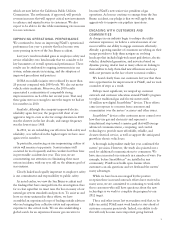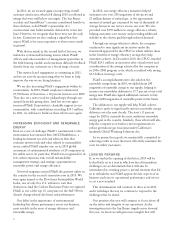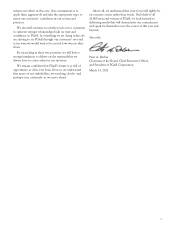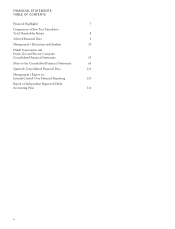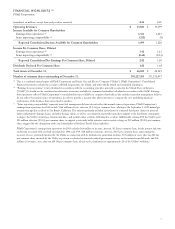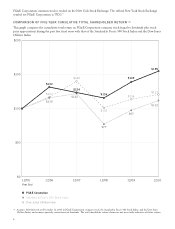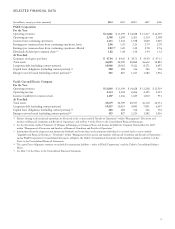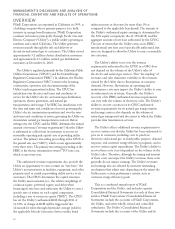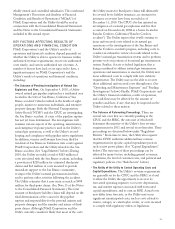PG&E 2010 Annual Report Download - page 6
Download and view the complete annual report
Please find page 6 of the 2010 PG&E annual report below. You can navigate through the pages in the report by either clicking on the pages listed below, or by using the keyword search tool below to find specific information within the annual report.reported in accordance with generally accepted accounting
principles (GAAP).
On a GAAP basis, net income after dividends on
preferred stock (also called “income available for common
shareholders”) was $1.10 billion, or $2.82 per share, for
2010. This compared with $1.22 billion, or $3.20 per share,
for 2009.
The year-over-year decline in net income reflected San
Bruno-related costs totaling $283 million on a pre-tax basis,
or $0.43 per share. These costs included a $220 million
provision for property damage, personal injury, and other
third-party claims, as well as an additional $63 million in
direct costs for providing support to the San Bruno
community, re-inspecting natural gas lines, and other
activities. Although we expect that most of the costs the
utility incurs for third-party claims relating to the accident
will ultimately be recovered through insurance, GAAP
required us to record a charge equal to the low end of the
estimated range for potential liability costs of $220 million
to $400 million.
On an earnings from operations basis, a non-GAAP
measure adjusted to reflect normal operations and exclude
items like the accident-related costs, earnings per share rose
6.5 percent to $3.42, on earnings of $1.33 billion,
compared to $3.21 per share, or $1.22 billion, in 2009.
(The “Financial Highlights” table on page 7 reconciles
GAAP total net income with non-GAAP earnings from
operations.) These results were well within the company’s
2010 guidance range of $3.35 per share to $3.50 per share
for earnings from operations.
STRENGTHENING THE UTILITY’S
INFRASTRUCTURE
We continued to invest substantially in our system last
year, deploying $3.9 billion of new capital to expand and
improve our gas and electric assets, strengthen safety and
reliability, and meet the needs of new customers.
Within our electric distribution and transmission
operations, a major focus was continuing to upgrade
targeted transmission and distribution circuits and install
new equipment to improve reliability. Additionally, we
secured regulatory approval to invest an additional $357
million of capital through 2013 for PG&E’s Cornerstone
Improvement Program. This program aims to create more
capacity and interconnectedness on the power grid,
enabling us to better isolate power outages and redirect
power flows onto neighboring circuits to restore service
more quickly.
We also continued to invest in PG&E’s natural gas
system, with an emphasis on retrofitting or replacing older
transmission and distribution pipe. This work has been a
long-term priority, and in light of the San Bruno accident,
we are accelerating and expanding many plans to reinforce
our gas infrastructure.
The focal point for this work going forward is a
proposed new 10-year pipeline modernization program,
Pipeline 2020. Announced late last year, Pipeline 2020 is
one of the most significant initiatives PG&E has ever
launched, with ambitious goals and a sweeping scope.
Pipeline 2020 will propose to make targeted investments
to test, inspect, and upgrade or replace parts of our
transmission pipeline system, and to add remote-controlled
or automatic shut-off valves in locations in our system
where they can be effective. It will drive advancements in
best practices across the industry and also includes funding
to support new research into next-generation pipeline
inspection technology. In addition, it encompasses efforts
to create a new model for coordinating with local first
responders and community leaders and increasing pipeline
safety awareness.
In the coming months, we plan to share with California
regulators our proposals for the first phase of this gas
infrastructure modernization work that we believe is
important to creating a safer and more reliable energy
future for our customers.
In 2010, we also continued to grow PG&E’s
conventional electric generation portfolio as we began
operations at the new units at our Humboldt Bay
Generating Station and the new state-of-the-art Colusa
Generating Station. We also received CPUC approval to
purchase the Oakley Generating Station, a natural-gas-fired
facility that is forecast to be the most efficient power plant
of its kind in California when PG&E takes ownership,
which is scheduled for 2016.
For the first time in our recent history, we also added
renewable generation to our utility-owned portfolio with
the inauguration of the Vaca-Dixon photovoltaic solar
station. This represents the first major project under our
five-year program to develop up to 500 megawatts of clean
solar photovoltaic power, 250 megawatts of which will be
owned by PG&E. When the entire program is online, we
expect that it will provide enough renewable power each
year to serve roughly 150,000 homes.
Finally, our Diablo Canyon nuclear power plant
continues to provide safe, carbon-free electric power for
our customers. As the regulatory process for relicensing this
essential facility moves forward, our focus remains on
ensuring safe and reliable operations.
Among last year’s most notable accomplishments were
settlements reached in PG&E’s 2011 General Rate Case and
its 2011 Gas Transmission and Storage Rate Case, both of
2



